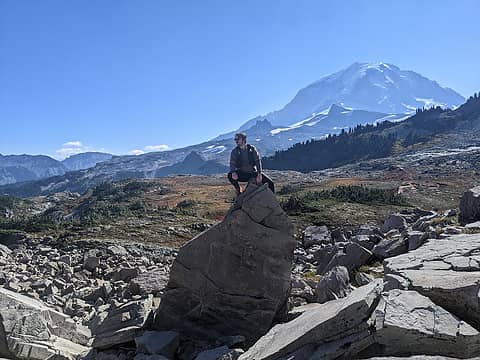| Previous :: Next Topic |
| Author |
Message |
Joey
verrry senior member


Joined: 05 Jun 2005
Posts: 2797 | TRs | Pics
Location: Redmond |
 |
Joey
verrry senior member
|
 Wed Nov 17, 2021 4:20 pm |
|
|
Personally I use an iPhone and a compass app is part of iOS.
But I am working on a project where I want to be able to recommend a compass app for Android.
Suggestions anyone?
|
| Back to top |
  
|
 |
zimmertr
TJ Zimmerman


Joined: 24 Jun 2018
Posts: 1227 | TRs | Pics
Location: Issaquah |
 |
zimmertr
TJ Zimmerman
|
 Wed Nov 17, 2021 4:36 pm |
|
|
Warning: Not a hardware engineer so these anecdotes may be incorrect. But to my knowledge, smart phones don't have normally have an internal magnet. The use of one would cause interference with the communication chips. They instead rely on receptors that detect low frequency signals from a North/South direction and, in tandem with your phones accelerometer, predict the direction the device is facing. So it's a different type of a magnetometer than a traditional magnet-on-water compass. Since your phone has a ton of radios in close proximity to one another this interference dulls the accuracy.
So I can't really recommend an app, because they're all just going to interface with these sensors in more-or-less the same way. Which is fairly flawed in terms of accuracy when compared to a traditional compass.
Sorry for the non-answer.
EDIT: https://en.wikipedia.org/wiki/Hall_effect_sensor
|
| Back to top |
  
|
 |
texasbb
Misplaced Texan


Joined: 30 Mar 2009
Posts: 1153 | TRs | Pics
Location: Tri-Cities, WA |
 |
texasbb
Misplaced Texan
|
 Wed Nov 17, 2021 4:48 pm |
|
|
| Joey wrote: | | I want to be able to recommend a compass...
Suggestions anyone? |

 RumiDude, Pyrites RumiDude, Pyrites
 RumiDude, Pyrites RumiDude, Pyrites |
| Back to top |
  
|
 |
Malachai Constant
Member


Joined: 13 Jan 2002
Posts: 16092 | TRs | Pics
Location: Back Again Like A Bad Penny |
I have one called compass on my Android by NixGame from the android store. It seems to work and gives lat and long and speed probably off GPS. Very simple I seldom use it except to line up weather vane.
"You do not laugh when you look at the mountains, or when you look at the sea." Lafcadio Hearn
"You do not laugh when you look at the mountains, or when you look at the sea." Lafcadio Hearn
|
| Back to top |
  
|
 |
Randito
Snarky Member


Joined: 27 Jul 2008
Posts: 9513 | TRs | Pics
Location: Bellevue at the moment. |
 |
Randito
Snarky Member
|
 Wed Nov 17, 2021 5:27 pm |
|
|
I use GaiaGPS on my android handset and carry a laser print GaiaGPS paper map and a basic Silva Compass
|
| Back to top |
  
|
 |
Cyclopath
Faster than light


Joined: 20 Mar 2012
Posts: 7733 | TRs | Pics
Location: Seattle |
 |
Cyclopath
Faster than light
|
 Wed Nov 17, 2021 5:42 pm |
|
|
If you have a Samsung it might already come with a compass as part of the Edge Panel. Go into the settings, it has its own page.
My Garmin watch has a built in compass, it's quicker and more convenient to check the watch than the phone, and the watch battery is much better. So I don't do this by phone.
|
| Back to top |
  
|
 |
Cyclopath
Faster than light


Joined: 20 Mar 2012
Posts: 7733 | TRs | Pics
Location: Seattle |
 |
Cyclopath
Faster than light
|
 Wed Nov 17, 2021 5:44 pm |
|
|
| zimmertr wrote: | | Sorry for the non-answer. |
This is quality info. I wasn't aware, and it's good to know that my phone's compass is less trustworthy than others if I ever wind up needing it. As far as I know this knowledge doesn't have a weight penalty, so I'm not seeing a down side here. 
|
| Back to top |
  
|
 |
Joey
verrry senior member


Joined: 05 Jun 2005
Posts: 2797 | TRs | Pics
Location: Redmond |
 |
Joey
verrry senior member
|
 Wed Nov 17, 2021 6:20 pm |
|
|
Think of the hikers you see that at best are maybe carrying 2 or 3 essentials.
They will not have a paper map or real compass.
But many of them will likely have a cell phone.
Those folks are the reason for my inquiry about an android compass app.
And even if compass apps are not perfect regarding telling you magnetic north, I think this is an example of a situation where perfection is the enemy of good enough.
All of this is part of the GeoJPG mapping project I am working on.
Map part is done and works fine.
Working on a website (geojpg.com) - no content yet.
 mike, zimmertr mike, zimmertr
 mike, zimmertr mike, zimmertr |
| Back to top |
  
|
 |
jstern
Member


Joined: 04 Apr 2010
Posts: 29 | TRs | Pics
Location: Auburn |
 |
jstern
Member
|
 Thu Nov 18, 2021 11:29 am |
|
|
I have an Android and am using an app called Smart Compass by Smart Tools. It is a free app, so you have to put up with ads and such, and it also provides lat/long and elevation and overall, seems to work ok, although I do not depend on it, as I also carry map/compass.
It does have an Ad-free version, but I am not sure whether its any better ad free or not.
"Adventure is just bad planning." - Roald Amundsen
"Adventure is just bad planning." - Roald Amundsen
|
| Back to top |
  
|
 |
Randito
Snarky Member


Joined: 27 Jul 2008
Posts: 9513 | TRs | Pics
Location: Bellevue at the moment. |
 |
Randito
Snarky Member
|
 Thu Nov 18, 2021 12:13 pm |
|
|
The are plenty of physical compasses available for under $10 and they don't require batteries and wont be popping up ads during usage.
Perhaps a compass app makes sense if someone wants to try out orienteering without spending $10 for a physical compass.
For general mountain travel usage -- I don't understand the utility -- if you have a charged phone it makes more sense to me to use GPS mapping app. If the phone dies -- that's when a paper map and a physical compass are useful backup navigation tools.
 InFlight InFlight
 InFlight InFlight |
| Back to top |
  
|
 |
Joey
verrry senior member


Joined: 05 Jun 2005
Posts: 2797 | TRs | Pics
Location: Redmond |
 |
Joey
verrry senior member
|
 Thu Nov 18, 2021 2:06 pm |
|
|
Thanks for all the info and suggestions.
|
| Back to top |
  
|
 |
Riverside Laker
Member


Joined: 12 Jan 2004
Posts: 2818 | TRs | Pics
|
| zimmertr wrote: | | They instead rely on receptors that detect low frequency signals from a North/South direction and, in tandem with your phones accelerometer, predict the direction the device is facing. |
So what happens when you calibrate the "compass", say in the Peakfinder app, it asks you to wave your phone in an infinity (sideways figure 8) motion several times? I use an iPhone.
Joey, it's frustrating when people don't answer your question! (Like this post...)
|
| Back to top |
  
|
 |
Joey
verrry senior member


Joined: 05 Jun 2005
Posts: 2797 | TRs | Pics
Location: Redmond |
 |
Joey
verrry senior member
|
 Fri Nov 19, 2021 5:38 am |
|
|
| Riverside Laker wrote: | | So what happens when you calibrate the "compass", say in the Peakfinder app, it asks you to wave your phone in an infinity (sideways figure 8) motion several times? I use an iPhone. |
That info applied to earlier versions of iOS.
I am not sure when this changed but the compass in iOS 15 automatically calibrates.
But see: https://www.iphonetricks.org/how-to-fix-iphone-compass-not-working/
I was not aware that the iOS compass can be set to either true north (default) or magnetic north.
|
| Back to top |
  
|
 |
zimmertr
TJ Zimmerman


Joined: 24 Jun 2018
Posts: 1227 | TRs | Pics
Location: Issaquah |
 |
zimmertr
TJ Zimmerman
|
 Fri Nov 19, 2021 10:03 am |
|
|
| Riverside Laker wrote: | | zimmertr wrote: | | They instead rely on receptors that detect low frequency signals from a North/South direction and, in tandem with your phones accelerometer, predict the direction the device is facing. |
So what happens when you calibrate the "compass", say in the Peakfinder app, it asks you to wave your phone in an infinity (sideways figure 8) motion several times? I use an iPhone. |
I don't really know why. If I had to guess moving a phone in a figure 8 pattern allows the Hall Effect Sensor to grab a ton of data points for various positions in a magnetic field by changing positions on the X, Y, and Z axes. And software always works better with more data points.
If I understand things correctly, a Hall Effect Sensor works by measuring voltages that are produced as a conductor moves through a magnetic field. So putting your phone in all of the different physical configurations allows the sensor to predict the northward direction a multitude of times and then average the results to reduce inaccuracy.
| Riverside Laker wrote: | | Joey, it's frustrating when people don't answer your question! (Like this post...) |
My point in all of this is really that these applications won't really behave differently. They're all interacting with the phone's hardware through the same API interface and working with the same data. So the differences between them are moreorless how much personal data they collect and sell about you based on the permissions they request as well as how prevalent their ad placement is.
It's kinda like asking for a Flashlight app. All of them do the same thing: Turn on and off your phone's rear-facing LED.
My recommendation I guess would be to find the cheapest one that still costs money. Or an open source one with which you need to sideload the APK. Since their business models are likely to be the least malicious.
|
| Back to top |
  
|
 |
Riverside Laker
Member


Joined: 12 Jan 2004
Posts: 2818 | TRs | Pics
|
| zimmertr wrote: | | If I had to guess moving a phone in a figure 8 pattern allows the Hall Effect Sensor to grab a ton of data points for various positions in a magnetic field by changing positions on the X, Y, and Z axes. |
In Peakfinder, it's not clear if the figure 8 is on a horizontal or vertical plane (or neither). I interpret the app as moving on a vertical plane, which doesn't make sense for magnetic direction. We recently were in Utah, where the magnetic declination was quite different, and the calibration seemed to work relatively well. But now I can't remember if I waved around vert or horz!
|
| Back to top |
  
|
 |
|
|